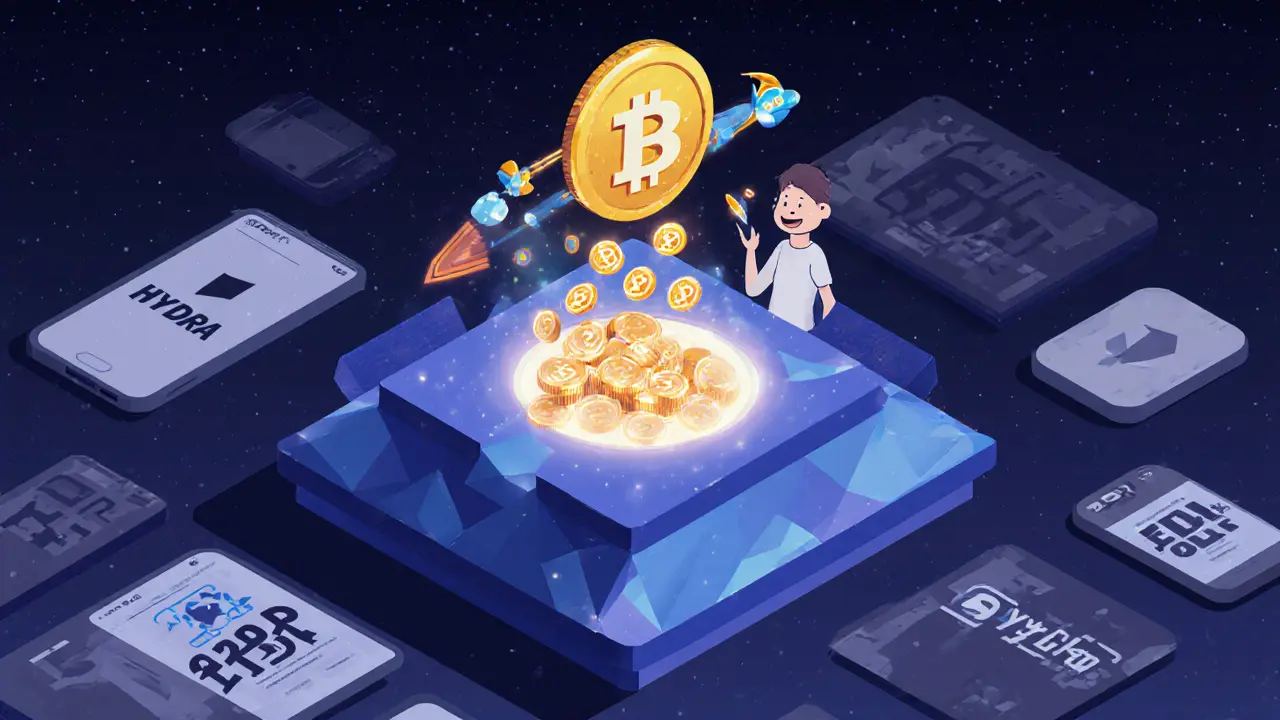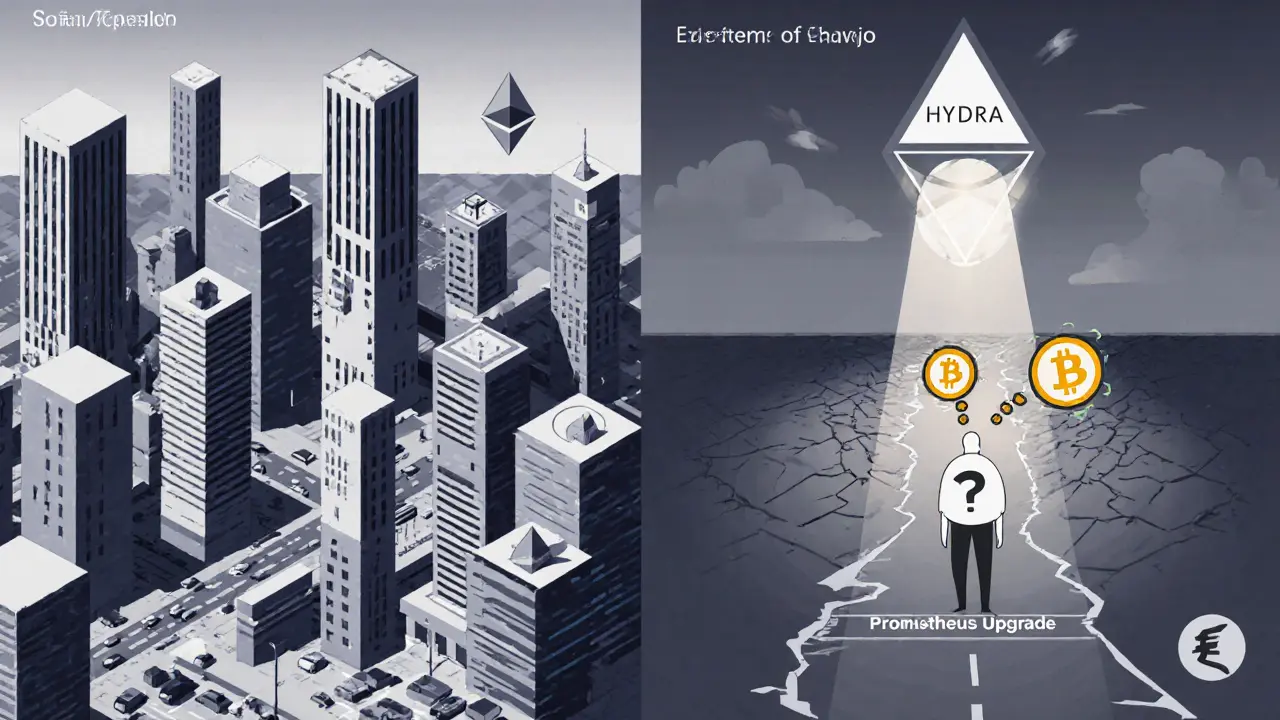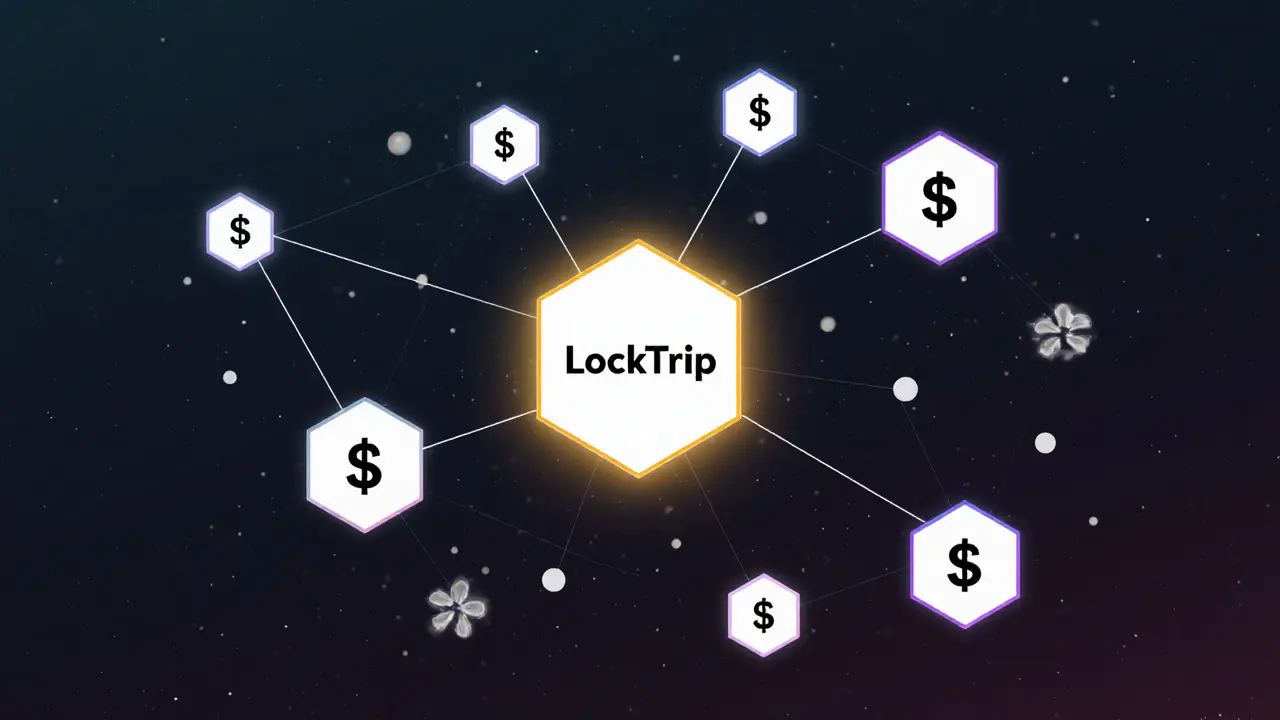Hydra Staking Reward Calculator
Staking Calculator
Hydra (HYDRA) isn’t another big-name crypto like Bitcoin or Ethereum. It’s a small, niche blockchain that tries to solve a very specific problem: making transaction fees predictable for decentralized apps. Launched in 2020 by the team behind LockTrip - a decentralized travel booking platform - HYDRA was built out of necessity. The developers kept running into unpredictable gas fees on Ethereum and needed something more stable for their own use case. So they built their own chain.
How HYDRA Works: Fixed Fees and Gas Royalties
Most blockchains charge fees in their native token, which means if the token price spikes, your transaction costs spike too. HYDRA does something different: it charges a fixed USD value for each transaction. If a transaction is supposed to cost $0.01, it always costs $0.01 - even if HYDRA’s price goes from $0.10 to $1.00. The protocol automatically adjusts how many HYDRA tokens you need to pay to hit that $0.01 target. It’s a clever workaround for businesses that need predictable costs.
Another unique feature is its gas royalty system. When someone uses a smart contract on HYDRA, 20% of the transaction fee goes directly to the contract’s creator. This is rare. Most chains don’t reward developers after deployment. On HYDRA, if you build a useful tool, you earn a cut every time someone uses it. It’s a small incentive, but it’s one of the few mechanisms that actually aligns developer rewards with real usage.
Technical Specs: Speed, Sharding, and LYDRA
HYDRA claims sub-second finality - about 0.5 seconds. That’s faster than Ethereum (2-15 seconds) and close to Solana (0.4 seconds). But speed alone doesn’t mean much if no one’s using it. The chain uses horizontal sharding to scale, meaning it splits work across multiple chains to handle more transactions. The exact throughput isn’t published, but it’s nowhere near Solana’s 65,000 transactions per second.
Then there’s LYDRA, HYDRA’s liquid staking token. When you stake your HYDRA, you get LYDRA in return - a token that represents your staked amount. You can trade LYDRA, use it in DeFi, or even borrow against it. Unlike other liquid staking systems, LYDRA is fully collateralized by your own staked tokens. There’s no third party holding your assets. No counterparty risk. That’s a solid design.
Market Reality: Tiny, Illiquid, and Overlooked
As of November 2023, HYDRA’s market cap sits around $3.8 million. That’s less than the price of a single rare NFT. It ranks #1587 out of over 20,000 cryptocurrencies on CoinGecko. Daily trading volume? Around $70,000. Compare that to Ethereum’s $24 billion in daily volume. You can’t even buy a cup of coffee on HYDRA without worrying about slippage.
Liquidity is the biggest problem. Users on Reddit and CoinSwitch report buying the wrong HYDRA token because there’s another one on Solana with the same ticker. That’s a red flag. If users can’t even find the right asset, adoption will never grow. Trading is slow. Orders take minutes to fill. Some wallets don’t support it. Exchanges list it, but few people trade it.

Who’s Using HYDRA? (Spoiler: Not Many)
The only real application built on HYDRA is LockTrip - the travel platform that started it all. In October 2023, LockTrip had just 87 daily active users. There are only 12 total dApps on the chain. That’s not a network. That’s a testnet.
Developer activity is nearly nonexistent. GitHub shows only three commits in the last 90 days. That’s not progress - it’s stagnation. Compare that to Solana, which has over 650 projects. Or even newer chains like Sei or Sui, which are attracting teams with better tools and bigger incentives.
The official Discord has 2,347 members, but only 12 are active in a week. The Twitter account has 8,421 followers - and posts get an average of 1.7 likes. That’s not a community. That’s a graveyard of hope.
Staking Rewards: The Only Real Upside
Here’s the one thing HYDRA does well: staking. Users report consistent annual yields of 14-15%. That’s higher than most major chains. One user on Investing.com said they’ve earned reliable payouts for eight months straight. If you’re holding HYDRA and don’t care about price appreciation, staking gives you passive income.
But here’s the catch: staking only makes sense if you believe the token will survive. If the project dies, your staked tokens become worthless. And with minimal developer interest and zero enterprise adoption, that’s a real risk.

Can HYDRA Survive? Experts Are Divided
Some analysts are bullish. CoinLore predicts HYDRA could hit $28 by 2026. But their model has contradictions - they predict a 2027 minimum price higher than their average price. That’s not forecasting. That’s guessing.
Others are harsh. CoinDesk’s Maria Rodriguez called HYDRA “a solution seeking a problem.” Why? Because the world doesn’t need another Layer 1 blockchain. We already have too many. And HYDRA doesn’t offer anything revolutionary - just a few niche tweaks.
The most balanced take comes from CoinGecko’s research team: they acknowledge the gas royalty system is smart, but they question whether it’s enough. With 0% market dominance and no real traction outside LockTrip, HYDRA is surviving on inertia, not innovation.
What’s Next? The Prometheus Upgrade
The team announced a major upgrade called Prometheus, aimed at improving load balancing and security. Version 2.3.1 rolled out in October 2023. Planned features include sentinel nodes (for better node reliability) and a unified cross-chain experience. But these were supposed to launch in late 2023 - and they’re delayed. That’s a pattern. Promises keep slipping.
If HYDRA wants to survive, it needs one of two things: either a massive partnership with a real business (like Booking.com or Airbnb), or a breakthrough that makes it the go-to chain for micropayments. Neither is happening.
Should You Buy HYDRA?
Only if you understand the risk. This isn’t an investment. It’s a speculative bet on a project that’s barely alive.
If you’re looking for:
- High returns? No. HYDRA’s price has dropped 80% from its all-time high of $1.00.
- Strong liquidity? No. You’ll struggle to sell without slippage.
- Developer activity or real adoption? No. The ecosystem is frozen.
- Staking income? Yes. If you’re okay holding long-term, the 14% APY is real.
HYDRA is a curiosity - not a contender. It’s a blockchain built for one app, by one team, with almost no community. It’s not going to change the crypto world. But if you’re curious, and you’re willing to lose your money, go ahead. Just don’t expect it to be the next Ethereum.
Is HYDRA a good investment?
HYDRA is not a good investment for most people. It has a tiny market cap, extremely low liquidity, and almost no adoption outside its original use case (LockTrip). While staking yields are high at around 14-15%, the token’s price has dropped 80% from its peak, and there’s little chance of significant growth without a major partnership or technological breakthrough. Only consider it if you’re comfortable losing your entire stake and are seeking passive income, not capital gains.
What makes HYDRA different from other blockchains?
HYDRA’s main differentiators are its fixed USD-denominated transaction fees and its gas royalty system. Unlike Ethereum or Solana, where fees fluctuate with token price, HYDRA keeps transaction costs stable in dollar terms. Also, 20% of every transaction fee goes to the smart contract creator - a rare incentive that rewards developers for building useful tools. These features are useful for businesses needing predictable costs, but they’re not enough to compete with larger chains.
Can I stake HYDRA, and how much do I earn?
Yes, you can stake HYDRA through the official wallet or supported platforms. Staking rewards are currently around 14-15% APY, paid out regularly. You receive LYDRA, a liquid staking token, in return for your staked HYDRA. LYDRA can be traded or used in DeFi without locking up your original tokens. Users have reported consistent payouts for over eight months, making staking the most reliable feature of the project.
Is HYDRA the same as the HYDRA token on Solana?
No, they are completely different. HYDRA on the Hydra blockchain is a Layer 1 proof-of-stake token with its own network and smart contract system. There’s a separate HYDRA token on Solana that’s unrelated - it’s a meme coin or utility token on that chain. Many users accidentally buy the wrong one because they share the same ticker symbol. Always check the contract address before buying. The real HYDRA blockchain token is listed on exchanges like KuCoin and Gate.io.
Why is HYDRA’s market cap so low?
HYDRA’s market cap is low because it lacks adoption, developer activity, and liquidity. It was built for one application - LockTrip - which has fewer than 100 daily users. No major companies or developers are building on it. Trading volume is minimal, and most exchanges list it with little promotion. It’s essentially a small experiment that never scaled. With over 200 active Layer 1 blockchains, HYDRA has no competitive edge beyond its niche fee structure.
What’s the future of HYDRA?
The future of HYDRA depends entirely on its Prometheus upgrade and whether it can attract real users or partners. The roadmap includes security improvements and cross-chain features, but these have already been delayed. Without a major partnership - like a travel giant adopting LockTrip - or a surge in developer interest, HYDRA will likely remain a footnote in crypto history. Analysts estimate its survival probability at just 18% over the next five years. It’s not dead, but it’s not thriving either.

Matthew Gonzalez
November 7, 2025 AT 15:12It's wild how HYDRA's whole model is built on the idea that predictable fees matter more than hype. Most chains chase TVL and memes, but this one just wants to make micropayments work without making you sweat over gas spikes. Kinda refreshing, honestly. Not sexy, but functional.
Michelle Stockman
November 8, 2025 AT 23:2514% APY on a dead chain? Congrats, you just found the crypto equivalent of a sinking ship with a free life jacket.
Eric von Stackelberg
November 9, 2025 AT 02:07Consider the implications: a blockchain engineered for one company, with no institutional backing, minimal developer activity, and a token ticker duplicated on another chain. This is not an investment vehicle-it is a controlled experiment in economic fragility. The fact that anyone still holds it suggests systemic cognitive dissonance within the crypto community.
Emily Unter King
November 9, 2025 AT 20:59The gas royalty mechanism is actually a brilliant micro-incentive structure-aligning creator rewards with usage velocity. Most L1s treat devs like disposable contractors. HYDRA’s model is a quiet revolution in sustainable dApp economics. The problem isn’t the tech-it’s the total lack of marketing, community building, and developer tooling. It’s like inventing a better carburetor and leaving it in a garage.
Michelle Sedita
November 10, 2025 AT 04:53I get why people dismiss it-it’s tiny, quiet, unglamorous. But sometimes the most useful things aren’t the flashiest. I’ve been staking for 10 months and never had a missed payout. That’s more than I can say for half the DeFi protocols I’ve tried. Maybe it’s not the next Ethereum… but it’s still working.
John Doe
November 11, 2025 AT 13:15They’re all in on this… I’ve seen the patterns. The same team behind LockTrip? That’s a shell company. They’re laundering crypto through travel bookings. The ‘gas royalties’? That’s just a way to funnel funds back to insiders. And LYDRA? It’s not even fully collateralized-they’re using it to mint synthetic assets. I’ve got screenshots from the private Discord. Someone’s getting rich while the rest of us hold garbage. 🕵️♂️💸
Ryan Inouye
November 12, 2025 AT 23:52Why does America let this garbage get any attention? We’ve got real tech here-this is just some guy’s side project with a fancy whitepaper. If this was built in China or Russia, it’d be banned as a scam. But no, we let it live because ‘decentralization.’ Pathetic.
Cydney Proctor
November 13, 2025 AT 16:44Calling it a ‘niche blockchain’ is generous. It’s a graveyard with a staking dashboard. The fact that anyone still believes in this after 4 years of zero adoption speaks volumes about the intellectual bankruptcy of retail crypto.
Cierra Ivery
November 14, 2025 AT 21:07Wait-so you’re saying… the fixed fee… is… USD-denominated? And… the devs get… 20%… of every transaction? And… LYDRA is… collateralized? And… no third party? And… it’s on… KuCoin? And… LockTrip has… 87 users? And… the team hasn’t pushed… Prometheus… on time? And… market cap is… $3.8M? And… daily volume is… $70K? And… the Discord has… 12 active? And… the Twitter likes are… 1.7? And… it’s… not… dead? But… not… alive? And… you’re… still… staking? Why? WHY?!!!!
Veeramani maran
November 16, 2025 AT 07:40bro hydra is dope i staked 5000 and got 700 hydra in 6 month! lydra is lit u can use it in pancake swap also! the team is chill and they reply on discord sometimes! i think next year it go to 5 dollar for sure! 🚀
Kevin Mann
November 17, 2025 AT 10:27Okay so imagine this: you’re sitting there, sipping your oat milk latte, scrolling through your phone, and you see HYDRA’s 14% APY… and you think, ‘Man, I could use some passive income…’ so you stake… and then… you wake up… six months later… and your wallet still has the same amount… but your bank account? Still empty. But hey-you got those sweet, sweet LYDRA tokens… which you can’t even use for anything real… except maybe… paying for a coffee… if the barista accepted crypto… which they don’t… and your only ‘community’ is a Discord with 12 people who all say ‘to the moon’ in all caps… and you’re like… ‘Wait… did I just become a crypto monk?’ 🙏💸
Kathy Ruff
November 18, 2025 AT 19:44It’s not a great investment, but if you’re holding it for the staking rewards and you’re okay with zero price growth, it’s not the worst thing in the world. I’ve been in crypto since 2017-I’ve seen way worse. At least HYDRA doesn’t rug. The team’s quiet, but they’ve delivered on payouts. That’s more than most.
Robert Bailey
November 19, 2025 AT 08:06Staking’s real. The rest? Meh. If you’re not trying to get rich quick, it’s a chill little corner of crypto. Like a quiet library in a noisy city.
Wendy Pickard
November 21, 2025 AT 04:21I appreciate the honesty in this post. It’s rare to see a project called out so clearly without being mean. HYDRA’s not evil-it’s just… forgotten. And sometimes, forgotten things are the ones that quietly keep working.
Jeana Albert
November 22, 2025 AT 07:08YOU’RE ALL JUST DELUDED. THIS IS A PUMP AND DUMP. THE TEAM IS SELLING ON EVERY RALLY. THE ‘STAKING REWARDS’? THEY’RE JUST PRINTING NEW TOKENS TO PAY YOU. THE CONTRACT ADDRESS ISN’T EVEN VERIFIED ON ETHERSCAN. I’VE BEEN WATCHING THIS FOR 18 MONTHS. THEY’RE ABOUT TO ABANDON IT. YOU’RE ALL LOSING MONEY AND YOU DON’T EVEN KNOW IT. 🤬
Sierra Rustami
November 24, 2025 AT 05:46Why do we keep pretending small chains matter? We’ve got 200+ L1s. This isn’t innovation-it’s entropy with a website.